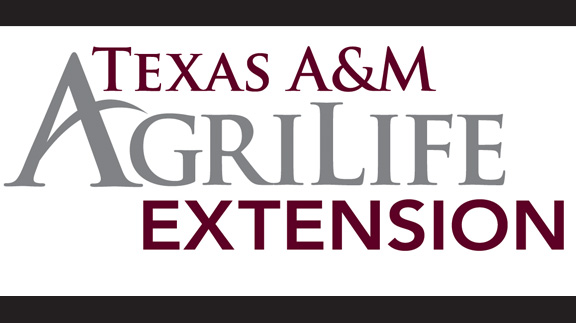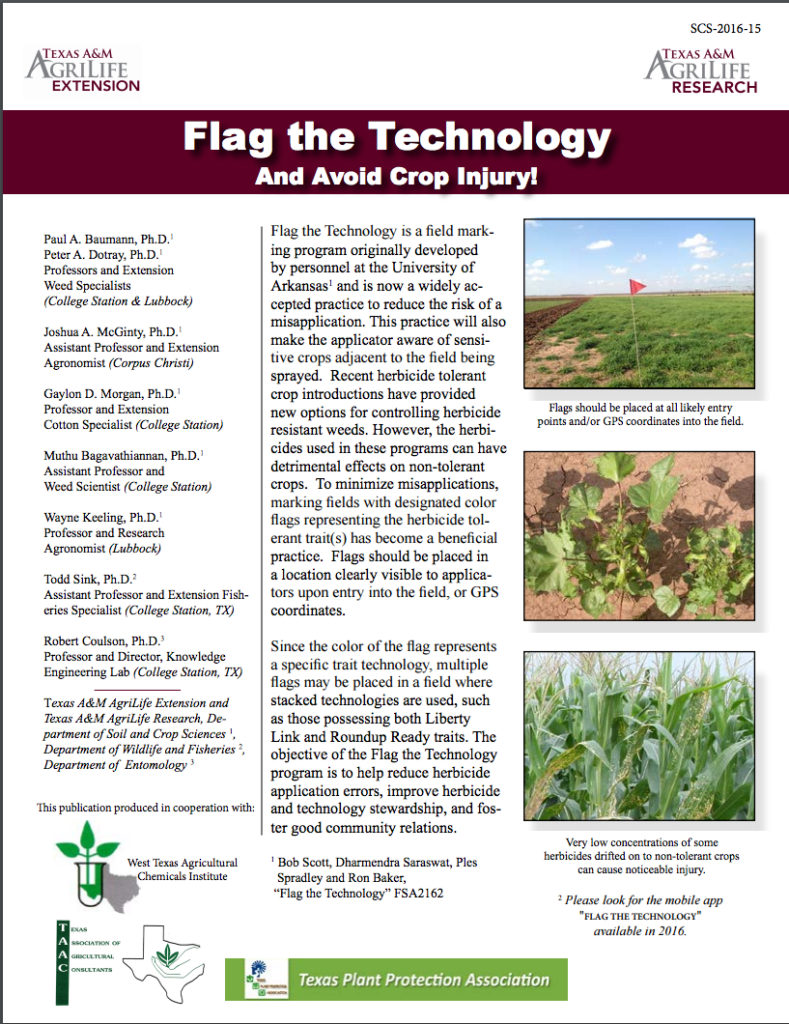Farm & Ranch
[AgriLife Today] ‘Flag the Technology’ helps farmers identify herbicide sensitive fields

By: Blair Fannin
Writer: Blair Fannin, 979-845-2259, [email protected]
COLLEGE STATION – The Texas A&M AgriLife Extension Service and the Texas Plant Protection Association have collaborated on a Flag the Technology program that identifies crop fields sensitive to certain herbicides.
With two new herbicide resistance technologies which will be widely used in cotton, corn and soybeans, program coordinators say it is critical farmers know which fields are safe for application of the new products and which are sensitive to them.
The program, which originated in Arkansas, is a system that helps farmers identify fields that are safe for application and those which must be avoided to prevent unintentional damage to the producers field or to adjacent crops. Farmers will place colored flags at entry points on fields, with each flag color representing a different kind of technology. This will make herbicide applicators aware which products are appropriate and safe to use on a specific field.
Texas Plant Protection Association chairman Ray Smith in College Station said during the association’s recent conference in Bryan the program and mobile app will “help enlighten our farmers on how to use the new technology. This app also emphasizes good recordkeeping.”
The mobile app can also be available to spray applicators who can check flag colors as they enter a field. The flag indicates which products they can use.
The following are flag colors and uses:
– White — Technology is tolerant to glyphosate herbicides.
– Green — Tolerant to glufosinate herbicide, Liberty.
– Yellow — Clearfield rice, sunflowers, wheat and canola which are tolerant to imidazolinone herbicides.
– Teal — Tolerant to both 2, 4-D and FOP (ACCase) herbicides, or Enlist technology. The white stripes indicate tolerance to glyphosate, Roundup. For Enlist cotton traits and soybean fields, a green flag should be added to denote tolerance to glufosinate herbicide (Liberty).
– Black and white checkered —Tolerant to both dicamba, Engina and Extendimax, and glyphosate, Roundup Ready Xtend.
– Red — Extreme caution required. Indicates conventional crops with no herbicide tolerant traits as well as sensitive production areas such as vegetables, vineyards, apiaries and organic production.
The new app builds on the field program developed by Bob Scott at the University of Arkansas, Smith said. Dr. Todd Sink, AgriLife Extension wildlife and fisheries specialist in College Station, developed the Flag the Technology app.
Users also have the option of meshing the app with Hit the Target, formerly known as Texas Crop Registry, a voluntary program that allows producers with sensitive crop areas to register specific fields, including non-GMO acres, orchards and others, said Dr. Bob Coulson, Texas A&M AgriLife Research entomologist.
“That information will be available to pesticide applicators,” Coulson said. “Individuals must register to use the system. Producers who register will specify field location and add the crop or sensitive nature of the area.”
Coulson said producers would need to calculate field dimensions. With that information logged in, Coulson said, the producer can go to the Flag the Technology program and select the color flag needed for the fields.
“The applicator will have a dashboard with the field profiles included to prevent off-target applications,” Coulson said. He added Hit the Target will soon transition to a new program, which can be accessed through a mobile device.
Sink said the Flag the Technology app is user friendly.
“It loads within five seconds,” he said. “The pesticide applicator is aware of where sensitive crops are located and can adjust flight plans to avoid those areas.”
The mobile app will be available free for iTunes and Google Play. A publication about the program is available for download at http://bit.ly/2j9Sce0 .
-30-
Find more stories, photos, videos and audio at http://today.agrilife.org
Farm & Ranch
Acorn Toxicity

By Barry Whitworth, DVM, MPH
With the prolonged drought, most pastures in Oklahoma end up in poor condition. With the lack of available forage, animals may go in search of alternative foods.
If oak trees are in the pastures, acorns may be a favorite meal for some livestock in the fall. This may result in oak poisoning.
Oak leaves, twigs, buds, and acorns may be toxic to some animals when consumed.
To read more, pick up a copy of the November edition of North Texas Farm & Ranch magazine, available digitally and in print. To subscribe by mail, call 940-872-5922.

Farm & Ranch
Silver Bluestems

By: Tony Dean
There are a handful of grasses on North Texas grazing lands ranchers need to know, not because they are highly desirable, but rather because they are not of much value. I call them “decom” plants, which is am acronym for “Don’t Ever Count On Me.” Silver bluestem is a “decom” grass.
Silver bluestem is a perennial which grows in all areas of Texas. It can survive in almost all soil types, and in full sun conditions or in semi shade. It grows up to three feet tall and is easily recognized with the presence of the white fuzzy seed head. Also, one of the identifying characteristics of Silver bluestem is a bend in the stems at each node, causing the plants to take on a rounded shape as they mature.
To read more, pick up a copy of the November edition of North Texas Farm & Ranch magazine, available digitally and in print. To subscribe by mail, call 940-872-5922.

Farm & Ranch
Meanwhile Back At The Ranch

By: Rayford Pullen
Fall is here which means winter is closing in on us and before we officially get into winter, we need to make sure our factories are either producing or will be producing in a few months.
We have been pregnancy testing our cows this fall and if they are not bred or nursing a calf, we are bidding them adios. With annual costs somewhere between $900.00 and $1,000.00 per cow, those cows not producing a live weaned calf are costing us quite a bit.
To read more, pick up a copy of the November edition of North Texas Farm & Ranch magazine, available digitally and in print. To subscribe by mail, call 940-872-5922.
-

 Country Lifestyles2 years ago
Country Lifestyles2 years agoScott & Stacey Schumacher: A Growth Mindset
-

 Country Lifestyles8 years ago
Country Lifestyles8 years agoStyle Your Profile – What your style cowboy hat says about you and new trends in 2017
-

 HOME8 years ago
HOME8 years agoGrazing North Texas – Wilman Lovegrass
-

 Equine1 year ago
Equine1 year agoThe Will to Win
-

 Country Lifestyles5 years ago
Country Lifestyles5 years agoAmber Crawford, Breakaway Roper
-

 Outdoor9 years ago
Outdoor9 years agoButtercup or Primrose?
-

 Country Lifestyles8 years ago
Country Lifestyles8 years agoJune 2016 Profile – The man behind the mic: Bob Tallman
-

 Country Lifestyles8 years ago
Country Lifestyles8 years agoDecember 2016 Profile, Rusty Riddle – The Riddle Way





